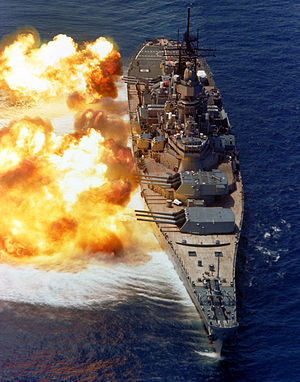16-50 Mark 7
| 16"/50 caliber Mark 7 gun | |
|---|---|

|
|
| Type | Naval gun |
| Place of origin | United States |
| Service history | |
| In service | 1943–1992 |
| Used by | US |
| Wars |
World War II Korean War Vietnam War Lebanese Civil War Gulf War |
| Production history | |
| Designed | 1939 |
| Specifications | |
| Weight | 267,904 lb (121,519 kg) |
| Length | 68 ft (20.73 m) |
| Barrel length | 66 ft 8 in/20.3 m (50 calibers) |
|
|
|
| Shell | AP Mark 8: 2,700 lb. (1,225 kg) HC Mark 13: 1,900 lb. (862 kg) Nuclear Mark 23: 1,900 lb. (862 kg) |
| Caliber | 16 in (406 mm) |
| Muzzle velocity | AP: 2,500 ft/s (762 m/s) HC & Nuclear: 2,690 ft/s (820 m/s) |
The 16"/50 caliber Mark 7 – United States Naval Gun was the main armament of the Iowa-class battleships.
Due to a lack of communication during design, the Bureau of Ordnance assumed the Iowa class would use the 16"/50 Mark 2 guns constructed for the 1920 South Dakota-class battleships. However, the Bureau of Construction and Repair assumed that the ships would carry a new, lighter, more compact 16"/50 and designed the ships with barbettes too small to accommodate a 16"/50 Mark 2 three-gun turret. The new 16"/50 Mark 7 was designed to resolve this conflict.
These guns were 50 calibers long—or 50 times their 16-inch (406 mm) bore diameter, which makes the barrels 66.6 feet (20 m) long, from breechface to muzzle. Each gun weighed about 239,000 pounds (108,000 kg) without the breech, and 267,900 pounds (121,517 kg) with the breech. They fired projectiles weighing from 1,900 to 2,700 pounds (850 to 1,200 kg) at a maximum speed of 2,690 feet per second (820 m/s) with a range of up to 24 miles (39 km). At maximum range the projectile spent almost 1½ minutes in flight. Each turret required a crew of 79 men to operate. The turrets themselves cost US$1.4 million each, to which the cost of the guns had to be added.
The turrets (technically they are "gunhouses") were "three-gun", not "triple", because each barrel could be elevated and fired independently. The ships could fire any combination of their guns, including a broadside of all nine. The turret interiors were subdivided and so designed as to permit the independent loading, elevation and firing of each gun. Each turret was also installed with an optical range finder and ballistic analog computer. This permitted the turret's gun captain and crew to locally engage targets, should battle damage disrupt communication with the ship's primary or auxiliary fire control centers. Contrary to popular belief, the ships did not move sideways noticeably when a broadside was fired; this is simply an illusion. With the enormous mass of the vessel and the damping effect of the water around the hull the pressure wave generated by the gunfire was felt much more than the slight change in lateral velocity.
...
Wikipedia
